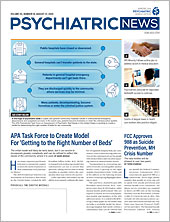Parenting is a complex, consuming task on a routine day. But now, as we are embroiled in a pandemic, our days are far from routine. Now seems to be a time of parenting in extremis, as many parents grapple with decisions that can feel like choices between their children’s physical and mental health. How can psychiatrists and mental health professionals support patients who are coping with new, indefinite stressors of parenting amid a pandemic?
There are many variables that parents (and other caregivers) cannot control. These differ among families, as each has its own set of resources, disadvantages, and privileges. By working with patients who are parents to identify the areas of their lives that are within their control may bring peace and strength during this challenging time.
One area where a parent can exercise control is in being present with their child or children. Letting children know they have the support and love of even a single adult can provide stability, self-confidence, and hope to children as they develop, no matter the chaos of other aspects of the environment.
Evidence from brain imaging studies show the presence of a parent can alter how a child’s brain responds to stress. One seminal imaging study found that the brains of children responded differently to frightening, unfamiliar situations depending on whether they were accompanied by their mother or not. Specifically, the children showed lower activity in the amygdala (brain region involved with fear response) when their mothers were present compared with when they were accompanied by a stranger during a behavioral test. The children also performed better on a behavioral test in the presence of their mother.
The findings suggest that the presence of a parent can quite literally remap children’s brains, making them more resilient and able to cope when feeling afraid. Even more, it is thought that as children develop, they solidify this circuitry. As a result, they become better able to regulate their emotions, even without their parents present, as they enter adolescence and grow into emotionally healthy adults.
We can encourage patients who are parents to cultivate intentional time with their children. When they do, we can remind these patients that they are offering their children both an immediate salve and a future tool by letting their children know they are accompanied on their journeys by someone who cares about them.
While parents engage in quality time with their children in the home, how can they foster meaningful presence between their child and the child’s family and friends outside the home during a time when physical distancing is of utmost importance? How can parents do this while also balancing concerns about passive screen time and its effects on mental health and the developing brain?
There are a few techniques caregivers can explore with their child. One is promoting active engagement when a child uses a screen to socialize. Instead of permitting hours of scrolling TikTok or Instagram, which may confer a superficial sense of connection, parents can encourage their child to videochat with family and friends. While imperfect, video chatting, as with in-person conversation, can help develop abilities in detecting and transmitting nonverbal cues, listening, and mirroring of another person, all in real time. These are highly important skills in the development of empathy.
Parents might also consider their child’s use of social media as an occasion for creative production rather than passive consumption. For example, parents and children can work together on a dance or comedy bit for the children to direct, record, and edit. Or parents can encourage children to post a photo they are proud of taking with a caption they spend time thinking about and writing. This sort of intentional engagement can promote self-reflection and skills in self-representation. Writing emails or letters to loved ones can also be occasions to practice introspection, storytelling, and composition.
With some grace for themselves as they dynamically adjust to new constraints and possibilities, our patients who are parents can model for their children how caring, devoted relationships—even ones tended amid a pandemic’s “social” distancing—are the bedrock for agile thriving and psychological wellness, no matter what their children’s futures hold. ■

